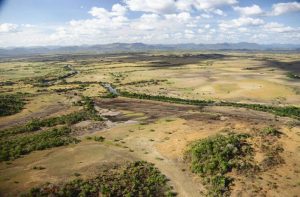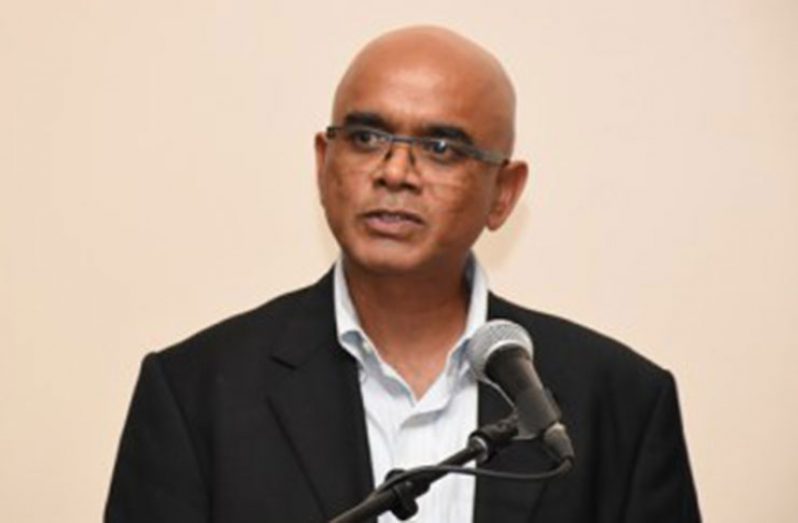– inhabitants need to learn, adapt as they contend with more frequent fires
A DISORIENTED tamandua struggles to make its way through the ashen surface of what was once part of lush, green ‘bush island’. Just about 15 feet ahead of medium-sized anteater, where the burnt vegetation greets the mostly intact grassland, small fires are still seen burning.
Three days of nonstop fire earlier this year, in April, ravaged acres of land at the Waikin Ranch which is located in the Rupununi, in Region Nine. Here, several animals were either injured or killed while their habitats were destroyed; the lush vegetation was replaced by burnt tree barks and ashes.
“We constantly survey the horizon for smoke or fire because we’ve become so conscious,” one of the owners of the ranch, Francesca Pires, told the Guyana Chronicle. “We’ve learnt to be conscious of wind direction and the terrain pathway for the fires.”

According to Pires, fires have become increasingly frequent in the Rupununi area, not just at Waikin. These fires, she said, may be caused by changing weather and climate patterns, but they are also caused by uncontrolled burning practices by persons in the area.
The Rupununi is located in Guyana’s interior savannahs. According to an article written by the World Wildlife Fund (WWF) Guyana office in 2016, this area is home to tens of thousands of species of plants, animals, and invertebrates, including many that are globally endangered.
The expansive landscape is largely open grasslands, but also encompasses bush islands, which are isolated forest patches; waterways such as lakes, creeks, rivers; lowland and gallery forests; and rocky outcrops.
The WWF noted that the Rupununi is one of the most biodiverse areas in South America; it provides a habitat for 80 per cent of Guyana’s birds, 86 per cent of mammals, and 60 per cent of fish.
“All these organisms are adapted to the Rupununi’s challenging climatic regime: infertile soils and the cycle of excessive water and drought,” the WWF said.
And to sustain their livelihoods within this climatic regime, ‘Rupununians’ have learnt a myriad of practices over the years. One such practice is the use of fire.
“The first thing to recognise is that fire has been part of the Rupununi landscape for centuries,” Former Executive Director of Conservation International Guyana, Dr. David Singh, told this newspaper. According to him, fires have traditionally been used, particularly by Indigenous persons, in a number of ways for a number of purposes.
Over the past few years, Professor of Geography at Royal Holloway University of London, Jay Mistry, has been conducting research in Guyana, Brazil and Venezuela on “Indigenous Fire Management”.
Speaking to the Guyana Chronicle, she related that Indigenous People have developed “sophisticated” ways of sustainably managing fires, particularly according to the time of year. An example of this is the “fire calendar” crafted by the Wapichan tribe.
Other stakeholders within the Rupununi region provided a bit more insight into the uses of fire.
OLD TRADITION
Member of the Rupununi Livestock Producers’ Association (RLPA), Rebecca Faria, highlighted that fires are sometimes lit by either poachers or rustlers. “This is part of an old tradition of lighting fire in the savannah to just before the rainy season so the green grass will be regrown then,” Faria explained. The grass then becomes suitable for grazing or for use as forage.
Additionally, President of Visit Rupununi, Melanie McTurk, related that fires are generally used to manage the land; grass is burnt to create easier pathways or to get rid of dry grass.
Jay, while engaging in her research, was told by Indigenous leaders that fires have become uncontrollable. She opined that this is, in part, attributed to the loss of “traditional knowledge” of burning.
When burning in the savannah, she related that the Indigenous Peoples would do several things to ensure that the fires could be controlled. These included the use of forest or savannah boundaries when burning in the dry season; patch burning, which involves small areas being burnt overtime, thus producing a “mosaic landscape” which prevents catastrophic fires; and inter-community agreements on burning of savanna and sacred forest areas.
When these fires go ‘out of control’, the damage is quite extensive. The three-day fire at Waikin ravaged the bush island, which is a small forest patch that is home to a number of wildlife species the Rupununi.
Anteaters, turtles and snakes attempted to scamper away from the burning vegetation, while spider monkeys sought higher ground to flee the fire. Soon enough, however, the trees would be burnt as well, destroying the habitat of itself and varieties of plant species.
On the wildlife front, Pires noted that wildlife is threatened with endangerment, and this is particularly worrying since the Rupununi is known as an abode for endangered animals. Added to that, she related the reproduction cycles of the animals are affected when they have to search for new habitats; this can negatively affect the population growth of animals, particularly those which are endangered.
Meanwhile, McTurk highlighted that the slower-growing species of plants, like the ‘hardwoods’ needed for construction are not able to re-grow if they are being burnt down so frequently.
Jay opined that it is important to reinforce those traditional fire knowledge and practices, so that fires are kept controlled.
“Portraying fire as ‘bad’ and people setting them as ‘wrong-doers’ doesn’t take into account the historical and cultural dimension of fire, and doesn’t help in managing it,” she said. “We need to have a better understanding of the changing context of fire, to be able to evaluate the potential impact on wildlife and people.”
Aside from reinforcing the traditional knowledge and practices, the livelihoods of the Rupununians must be linked to better practices as well.
‘HONEY HUNTING’

In Karanambu, persons engage in ‘honey hunting’ by searching for wild hives in the forests and drive the bees out by burning or smoking them out, before burning the honey. McTurk, who is also the manager of the Karanambu Lodge in the North Rupununi, indicated that fires in Karanambu were linked to this ‘honey hunting’ as well.
“There are a number of communities and a number of individuals within communities who this is a source of income for them, so what we have recognised is that you can’t just solve the problem by punishing people,” McTurk said.
Instead, she said the lodge will be partnering with the Rupununi Friendly Beekeepers to promote ‘Fire-Free’ honey, where persons are taught how to manage the hives in the wild, so we still have the richness and diversity of the Rupununi honey, without burning.
CLIMATE CHANGE
While people have been using fires in various ways to foster and sustain their livelihoods, fires are also just naturally caused by the effects of climate change. This phenomenon causes rapidly changing weather patterns and unpredictable weather conditions.
“When we have the dry season, we do have instances where the fires are created just from the heat. You have the dry grass, the dry weather and the dry conditions, so it is unfair to say that all the fires in the Rupununi are man-made,” McTurk underscored.
For Dr. Singh, the substantial impact of climate change is one which exacerbates the conditions that lead to fires in the Rupununi. The Rupununi has its dry season, which may cause droughts and its wet season which may sometimes lead to flooding. And this, according to Dr. Singh, demands greater attention be placed on managing the region.
“The savannah areas will increase as a result of drier climates in that part of the country and this means that we will have to step up our game in terms of having a far better early warning system and mechanisms in place to address forest fires when they do happen,” Dr. Singh explained.
Furthermore, he stressed that the drier the space becomes, naturally, the conditions would be more conducive for fires to spread and endure. El Niño is the name given to the severe dry season conditions.

In December 2017, President David Granger inked an agreement with the Brazilian government to help mitigate the ‘dry season’ and its stark effects. Through this agreement, wells are being drilled across the South Rupununi to provide relief when the dry season, particularly the El Niño season, comes.
Even with the wells, incidents do occur and will continue to occur, if not exacerbate and persons living in the Rupununi would need to adapt as well.
The Waikin Ranch is located about 30 minutes away from Lethem, which is the main hub of the Rupununi region. At Lethem, there is a fire tender which is currently manned by volunteers.
Mayor of Lethem, Carlton Beckles, related that this tender does not have a “huge capacity” and not much can be done for outlying regions, especially if the tender has to traverse great distances to get more water (for example, going to a creek).
However, he did highlight that the construction of a full-fledged fire station is almost complete. With this, there would be more fire tenders and more persons would be trained into a permanent fire response team. This, he said, should be able to help mitigate fires in the region.
Whether through human practices, climate change or a bit of both, the incidents of fires in the Rupununi is one which affects the wildlife, the landscape and the people and their livelihoods.
“One of the things that is so wonderful about the Rupununi is that we have a series of microhabitats with each one of those microhabitats are harbouring a unique collection of life at every level,” McTurk related. It is for this reason she believes that due diligence must be taken.
In an attempt to salvage the rich ecosystem at Waikin, the Pires family has replanted the area with forest and fruit trees. Francesca also stated that planning for the dry season also now starts months in advance.
This planning now being done at the Waikin ranch is one which Dr. Singh said is needed throughout the Rupununi. According to him, this planning must incorporate early warning systems, as well as education and awareness systems so that people could understand the potential harm and how to mitigate this. Climate resilient agriculture, which involves engaging in practices that would reduce the ‘climate stress’ on crops and livestock, is also needed.
All-in-all, however, Dr. Singh opined that fate of the tamanduas, and all the wildlife and forest resources, ultimately comes down to the devolution of decision-making down to the “local level”. He explained that this devolution would enable the “rights holders” or the Rupununians to take greater responsibility for the resources there.




.png)









